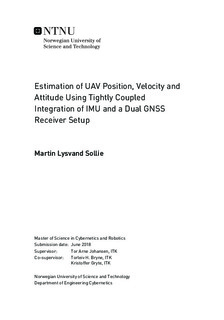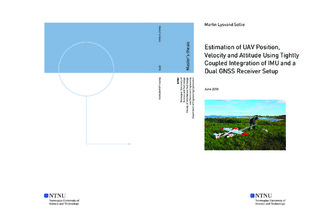| dc.description.abstract | Increasing use of UAVs in high-precision applications, such as georeferencing and photogrammetry, increases the requirements on the accuracy of the estimated position, velocity and attitude of the vehicle. Commercial systems that utilize magnetometers in the heading estimates are cheap, but are affected by disturbances from both the vehicle itself and variations in Earth's magnetic field. On the other side, commercial dual-antenna satellite navigation systems can provide the required accuracy, but are expensive. This thesis explores the use of a low-cost setup using two independent GPS receivers, aiding an inertial navigation system. A multiplicative extended Kalman filter using unit quaternions as the nominal attitude parametrization and an error state based on the Gibbs vector is derived and implemented as the estimation algorithm. The system model is driven by measurements from a Sensonor STIM300 inertial measurement unit. Raw GPS pseudorange, Doppler frequency and carrier phase measurements from two longitudinally separated U-Blox NEO-M8T receivers are used for corrections, taking into account the lever arm to each antenna. The filter uses carrier phase interferometry with double differencing of the carrier phase measurements, and estimates the related ambiguities as float values which are fixed to integer values using the LAMBDA algorithm. The results show that carrier phase interferometry enables accurate heading estimation in static conditions, but in highly dynamic conditions the heading is already observable without it, and is estimated well using only a single antenna in the test performed. Compared to the estimates from the flight controller, the velocity has less noise and is accurate on a centimeter level. The position from the implemented algorithm and the flight controller is quite consistent except for some drift in altitude, despite showing an eastward bias compared to RTKLIB. | |

